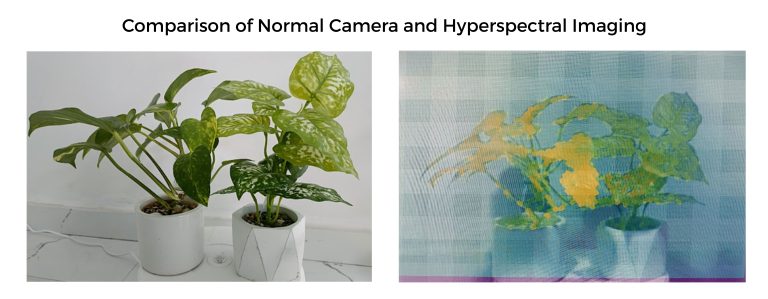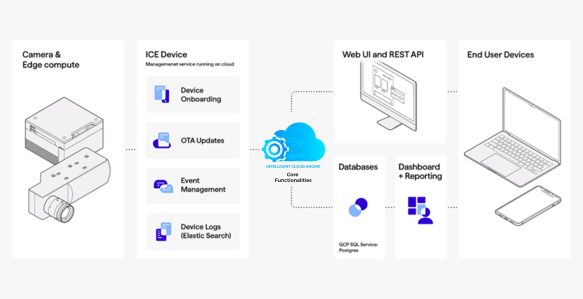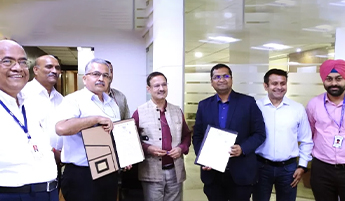In today’s rapidly advancing technological landscape, innovations in imaging and data analysis are reshaping how industries operate, solve problems, and push boundaries. As new technologies emerge, the need for more precise, detailed, and insightful information has grown across multiple fields, from agriculture and healthcare to defense, environmental monitoring, and beyond.
One of the emerging technologies today that is catching attention is hyperspectral imaging that enables detailed material analysis by capturing a wide range of wavelengths, transforming data interpretation across various sectors.
In this blog, we will delve into the basics of hyperspectral imaging, how it works, and its key applications.
We will also highlight and talk about an innovative joint solution from our partners Living Optics that offers a Hyperspectral Imaging camera integrated with VVDN ICE that provides a comprehensive solution for accessing and utilizing hyperspectral data efficiently.
What is a Hyperspectral Imaging Camera?
A hyperspectral imaging camera is a special camera that captures light from a scene and breaks it down into different colors or wavelengths. Instead of just taking a regular picture with red, green, and blue colors (like a normal camera), it creates an image where each point (or pixel) has detailed color information across many wavelengths.
Each pixel in the hyperspectral image holds information across a wide range of wavelengths, offering a complete spectrum for every point in the image. This unique capability allows for a deeper analysis of materials, surfaces, or environments, as it can detect subtle variations in the spectral signature of objects, which would be invisible in traditional RGB images.
How Hyperspectral Imaging Camera Works?
Hyperspectral imaging cameras provide a much richer dataset, revealing details invisible to the naked eye. An RGB sensor only captures three values per pixel, while HSI cameras can capture many more bands of light, offering 30 or more data points per pixel and extending beyond the visible spectrum. Typical RGB imaging covers a spectral wavelength range of 380 nm to 750 nm, while hyperspectral imaging usually spans from approximately 400 nm to 2,500 nm, and in some cases, may extend into the UV range below 400 nm or into the mid-infrared. Below is a graphical representation comparing RGB imaging and hyperspectral imaging:

Hyperspectral Imaging Camera Applications :
The applications of hyperspectral cameras are vast and diverse, as their ability to capture detailed spectral information across a wide range of wavelengths makes them highly valuable in numerous industries. Here are some of the major applications:
- Smart Agriculture: Hyperspectral imaging (HSI) cameras are transforming smart agriculture by enabling precise monitoring and management of crops and soil. They can detect plant health issues, nutrient deficiencies, and diseases through spectral analysis, allowing for early intervention. HSI also aids in soil analysis, weed detection, and pest identification, which enhances targeted treatments and reduces chemical usage. Additionally, it supports yield prediction, fertility mapping, and irrigation management by providing detailed insights into crop and soil conditions. This technology not only improves crop quality assessment and harvest timing but also contributes to sustainable practices by optimizing resource use and promoting environmental monitoring.
To elaborate the camera capability, we have placed two plants, the left plant is real one while the plant on the right is fake, hyperspectral imaging distinguishes between a real plant and a fake one by analyzing their spectral signatures, revealing differences in water content, chlorophyll levels, and other plant-specific characteristics.

- Defense: In defense, hyperspectral imaging (HSI) plays a crucial role in surveillance and reconnaissance by enabling the detection of camouflaged objects, vehicles, and personnel through their unique spectral signatures. It enhances target identification and tracking, allowing for improved situational awareness on the battlefield. HSI is also utilized for monitoring environmental changes in conflict zones and assessing the impacts of military activities. Furthermore, it aids in the detection of chemical and biological agents, contributing to homeland security and threat assessment. This technology enhances operational efficiency and safety for military forces.
- Healthcare: HSI offers innovative solutions for non-invasive diagnostics and tissue analysis. By capturing detailed spectral information, HSI can identify abnormal tissue characteristics, aiding in the early detection of diseases such as cancer. It allows for precise differentiation between healthy and diseased tissues, improving surgical planning and outcomes. Additionally, HSI is used to assess wound healing and monitor skin conditions, providing valuable insights for treatment strategies. This technology enhances diagnostic accuracy and supports personalized medicine approaches, ultimately improving patient care.
- Remote Sensing: Remote sensing utilizes spectral data to identify and track objects across various landscapes, effectively overcoming challenges posed by shadows and obstructions. By analyzing the unique spectral signatures of different materials, remote sensing technology can provide accurate information even in complex environments. This capability enhances monitoring efforts in applications such as agriculture, forestry, and urban planning, enabling more informed decision-making and improved management strategies.
The Living Optics and VVDN Technologies solution
One of the biggest barriers to adopting hyperspectral technology is the speed of existing imagers. With considerably more data to output, a typical hyperspectral camera faces challenges in providing real-time data, limiting its potential use cases.
With novel snapshot technology, Living Optics delivers a video-rate camera outputting high-resolution RGB and hyperspectral data with 100 bands in the visible and near-infrared spectral range.
Beyond providing real-time hyperspectral information, the camera is portable, easy to use, and compatible with various external systems via the Living Optics software development kit.
To facilitate the adoption of its technology, Living Optics, in collaboration with VVDN Technologies, has tailored VVDN’s Intelligent Cloud Engine (ICE). VVDN’s Intelligent Cloud Engine is a secure and scalable cloud platform designed for effortless management and secure connection of data from distributed devices. Offering swift onboarding and real-time data processing capabilities, the platform simplifies the setup process with minimal effort required.

By integrating the Living Optics camera into VVDN’s ICE, organizations gain convenient access to all essential services necessary for operating a fully connected IoT hyperspectral system. These services encompass seamless device onboarding, device management, data processing, event tracking and notifications, device logs, web UI, dashboards, reporting, and more. Together, Living Optics and VVDN provide a comprehensive solution for readily accessing hyperspectral data.
If you’re interested in learning more about our solution, please feel free to reach out to our experts at info@vvdntech.com. To schedule a demo, contact us at marketing@vvdntech.com





















